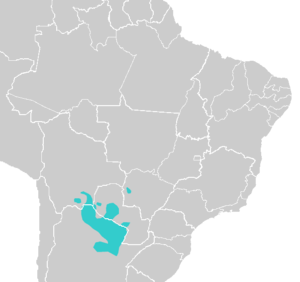Mataguayo–Guaicuru, Mataco–Guaicuru or Macro-Waikurúan is a proposed language family consisting of the Mataguayan and Guaicuruan languages. Pedro Viegas Barros claims to have demonstrated it.[1][2][3] These languages are spoken in Argentina, Brazil, Paraguay, and Bolivia.
| Mataguayo–Guaicuru | |
|---|---|
| Macro-Waikurúan | |
| (proposed) | |
| Geographic distribution | South America |
| Linguistic classification | Proposed language family |
| Subdivisions | |
| Language codes | |
| Glottolog | None |
 | |
Genetic relations
editJorge Suárez linked Guaicuruan and Charruan in a Waikuru-Charrúa stock. Kaufman (2007: 72) has also added Lule–Vilela and Zamucoan,[4] while Morris Swadesh proposed a Macro-Mapuche stock that included Matacoan, Guaicuruan, Charruan, and Mascoyan. Campbell (1997) has argued that those hypotheses should be further investigated, though he no longer intends to evaluate it.[5]
Language contact
editJolkesky (2016) notes that there are lexical similarities with the Arawakan, Tupian, Trumai, and Ofayé language families due to contact, pointing to an origin of Proto-Mataguayo-Guaicuruan in the Upper Paraguay River basin.[6]: 439
Classification
editInternal classification by Jolkesky (2016):[6]
(† = extinct)
- Macro-Mataguayo-Guaykuru
- Payagua †
- Guachi †
- Guaykuru
- Mataguayo
- Mataguayo, Western
- Chorote: Chorote Iyojwa'ja; Chorote Iyo'wujwa
- Wichi: Wichi Guisnay; Wichi Nokten; Wichi Vejoz
- Mataguayo, Eastern
- Mataguayo, Western
Chaco linguistic area
editCampbell and Grondona (2012) consider the languages to be part of a Chaco linguistic area. Common Chaco areal features include SVO word order and active-stative verb alignment.[7]
See also
editReferences
edit- ^ Pedro Viegas Barros (1992-1993). ¿Existe una relación genética entre las lenguas mataguayas y guaycurúes? Em: J. Braunstein (ed.), Hacia una nueva carta étnica del Gran Chaco V, 193-213. Las Lomitas (Formosa): Centro del Hombre Antiguo Chaqueño (CHACO).
- ^ Pedro Viegas Barros (2006). La hipótesis macro-guaicurú. Semejanzas gramaticales guaicurú-mataguayo. Revista UniverSOS, 3:183-212. Valencia: Universidad de Valencia.
- ^ Pedro Viegas Barros (2013). La hipótesis de parentesco Guaicurú-Mataguayo: estado actual de la cuestión. Revista Brasileira de Linguística Antropológica, 5.2:293-333.
- ^ Kaufman, Terrence. 2007. South America. In: R. E. Asher and Christopher Moseley (eds.), Atlas of the World’s Languages (2nd edition), 59–94. London: Routledge.
- ^ Campbell, Lyle (2012). "Classification of the indigenous languages of South America". In Grondona, Verónica; Campbell, Lyle (eds.). The Indigenous Languages of South America. The World of Linguistics. Vol. 2. Berlin: De Gruyter Mouton. pp. 59–166. ISBN 9783110255133.
- ^ a b Jolkesky, Marcelo Pinho de Valhery (2016). Estudo arqueo-ecolinguístico das terras tropicais sul-americanas (Ph.D. dissertation) (2 ed.). Brasília: University of Brasília.
- ^ Campbell, Lyle; Grondona, Verónica (2012). "Languages of the Chaco and Southern Cone". In Grondona, Verónica; Campbell, Lyle (eds.). The Indigenous Languages of South America. The World of Linguistics. Vol. 2. Berlin: De Gruyter Mouton. pp. 625–668. ISBN 9783110255133.
- Greenberg, Joseph H. (1987). Language in the Americas. Stanford: Stanford University Press.
- Kaufman, Terrence. (1990). Language history in South America: What we know and how to know more. In D. L. Payne (Ed.), Amazonian linguistics: Studies in lowland South American languages (pp. 13–67). Austin: University of Texas Press. ISBN 0-292-70414-3.
- Kaufman, Terrence. (1994). The native languages of South America. In C. Mosley & R. E. Asher (Eds.), Atlas of the world's languages (pp. 46–76). London: Routledge.